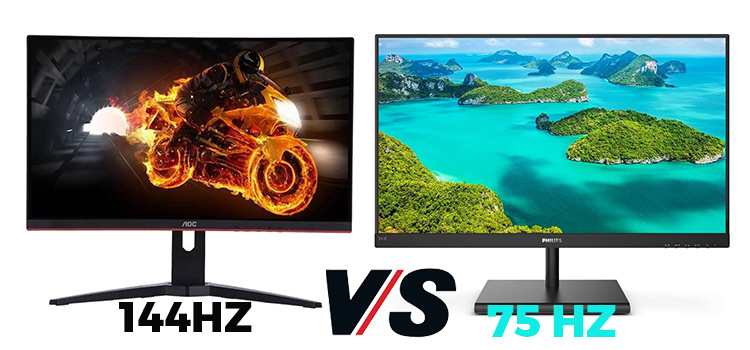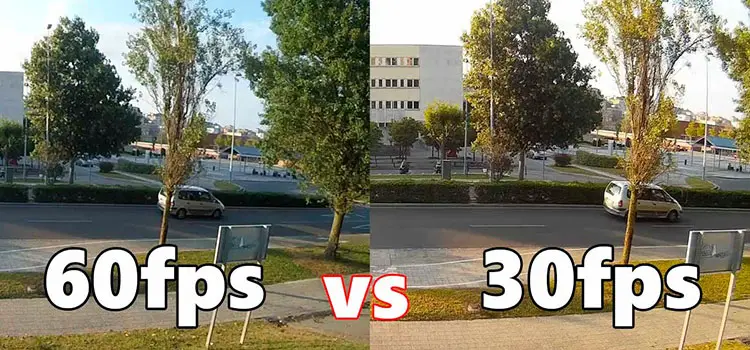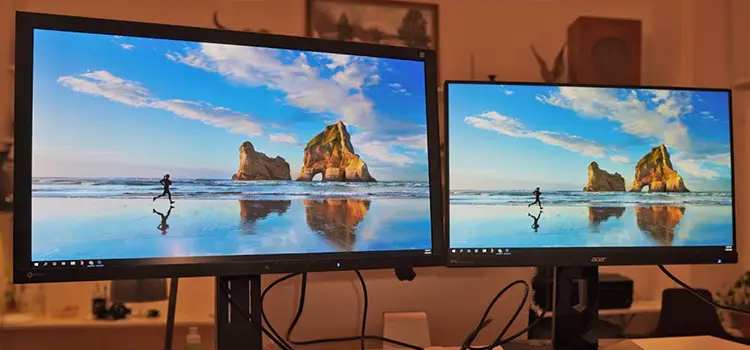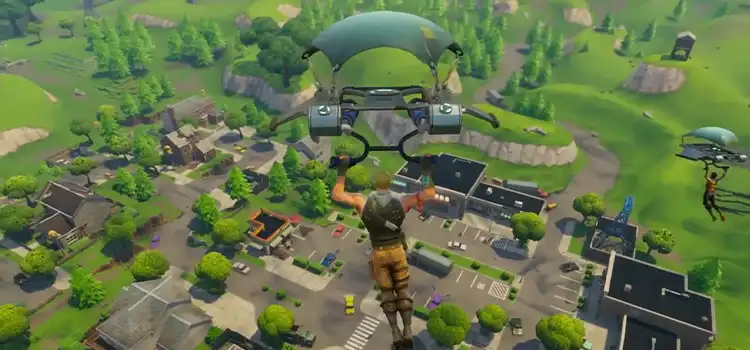144hz VA Panel vs 75hz IPS Panel | Distinctions Between the Panels
When shopping for a gaming monitor, you’ll come across several different sorts of panels. Those panels are responsible for displaying the picture and are consequently the most important portion of your monitor. These are the three most prevalent panel choices for gaming screens: TN, IPS, and VA, and I’ll discuss the distinctions between 144hz VA vs 75hz IPS in this article. Three aspects of this are taken into consideration: visual quality, refreshing rate, and speed of response.

Multi-Faceted Analysis on 144hz VA Panel and 75hz IPS Panel
A 144hz VA screen outperforms a 75hz panel in every aspect of performance. But if you’re a regular desktop user, or regular gamer, or a dedicated gamer, the increase in frame rate over 60/75Hz to 144Hz will be evident. Anything, from mouse motions to gaming activity, is noticeably smoother than it was previously. Anybody who is updating from a conventional 60Hz display to a 144Hz panel will notice a significant difference between the two displays. The increase in frequency from 60Hz to 75Hz, on the other hand, may not be as dramatic, but it is still detectable.
A 144Hz screen may be unnecessary for core gamers who prefer to play separate games on a laptop or desktop. For single gamer mission-driven games, and also entry-level and recreational gaming, a 75Hz display is an excellent choice. The most significant benefit is the cost: Monitors which refresh at 75 Hz are less expensive than those that refresh at 144 Hz, and they can work well with outdated GPUs which lack the ability to drive videogames at faster refresh rates.
When It Comes to Monitor Refresh Rates, Which Is Faster 144hz VA Or 75hz Ips?
A 144Hz VA monitor requires around 6.94 milliseconds to generate and produce a frame, whereas a 75Hz IPS display takes 13.33 milliseconds doing the same thing. A 144Hz monitor draws in a disproportionately shorter amount of time for each frame received. As a result, the latency caused by a 144Hz VA screen is far smaller than that caused by a 75Hz panel.
This essentially indicates that such a 144Hz VA screen is faster than a 75Hz IPS panel in terms of response time. When compared to a 75Hz monitor, any gaming task performed just on controllers, such as pressing a button to fire a rifle, displays significantly more quickly on the monitor.
Which Monitor Provides Smoother Gameplay, a 144hz VA or a 75hz IPS Display?
144Hz monitors update their screens 144 times per second, while 75Hz monitors update their screens 75 times per second, and here is the difference between them. This essentially means that a 144hz VA monitor can display 144 frames per second and while a 75hz IPS screen can only display 75 frames per second on the same screen. When compared to a 75hz IPS screen, a 144hz VA screen provides you with 69 extra frames to observe per second. Also as consequence, when playing on a 144Hz VA monitor, the gaming appears much faster.
Which One Is Better in Terms of the Visual Quality?
75hz IPS
The color spectrum of IPS panels is the widest available. This means that the images on these displays are the most accurate representations of the graphics in your games. This is linked to viewing angles thanks to the use of a 75hz IPS monitor, which allows you to see sharp images even when you’re not directly next to your gaming pc. Like, if you’re playing a game with a group of individuals at the very same moment.
144hz VA
A 144hz VA screen is a decent middle-of-the-road option among IPS displays. In terms of the color spectrum, it is comparable to an IPS panel, although the angle of elevation is considerably smaller than a 75hz IPS screen. The contrast ratio of 144hzVA gaming screens is particularly impressive. A huge difference in darkness and light may be seen quite clearly on this kind of monitor.
Which One Is Better in Terms of the Refresh Rate?
The refresh rate of a screen reveals how many frames each second it is capable of calculating. In Hz, this is the couple of times every second that such image is eventually converted, and it is expressed as a percentage. The most basic game displays have a refresh rate of 75Hz or 144Hz. Smoother scans are performed by increasing the number.
75hz IPS
A 75hz it’s screen, on the other hand, has the minimum refresh rate on the market. When it comes to these types of screens, a refresh rate of over 75Hz is considered a problem. This means that you will be able to keep playing with a greater resolution less fluidly than you will be able to do with more types of computer monitors. Although In-Plane Switching (IPS) displays are now in their early stages of development, the first displays with refresh rates up to 144Hz are already available. These are primarily found in the most expensive price ranges.
144hz VA
The 144hz VA screens at this house are likewise on the average defender. Even though many VA screens have such refresh rates over 60Hz, you will also discover displays with refresh rates of 120Hz or higher on this display. Even having a 144hz VA display, you will be able to play all of your favorite games with ease.
Which One Is Better in Terms of the Response Time?
The response time of a screen measures the amount of time it requires for dark pixels to turn white and then back to black. When playing quick games, you may encounter motion artifacts or ghosting if the reaction speed of the display is set too high for the situation. This can be distinguished by the presence of hazy streaks that trail after a rapidly moving object.
75hz IPS
The response time of IPS panels is not well-known for being fast, yet the majority of gaming screens using 75hz IPS have such responsiveness of 4 milliseconds or less. Many games are not adversely affected by this in any meaningful way. Do you spend a lot of time playing racing games or fast-paced shooters? If this is the case, you will experience ghosting. There still are currently some 75hz IPS game screens available with response times of 2ms or 1ms, demonstrating that technology isn’t stagnant in its advancement.
144hz VA
Monitors with a 144hz VA panel get the fastest response time by standard, with a response time of approximately 5 milliseconds. This indicates that you will be the most impacted by blurriness when using these displays. Development is also in high spirits in this area, as a consequence of which 144hz VA displays now feature panels that are significantly faster.
When it comes to online first-person shooter games, 144Hz is unquestionably the best option. It makes a lot of difference when the screen refreshes and reacts more quickly.
Freesync at 75Hz allows you to play more smoothly and without tearing. Whenever image appearance is your major concern, 75Hz IPS is a better frequency to use. It makes plenty of sense if the GPU is only capable of 75 frames per second and you don’t have any plans to update anytime soon.
Frequently Asked Questions
Is VA Panel Better than IPS?
Which one is better between VA panel and IPS panel, completely depends on user preferences. In most cases, IPS panels are significantly better than VA panels in viewing angles and color. VA panels normally contain deeper black levels and higher contrast which is also preferable for many users.
Should I Upgrade from VA to IPS?
IPS is better than VA in most cases. VA is capable of hitting 240HZ, while IPS hits 500Hz. Even VA displays are only capable of hitting 144Hz to 165Hz in some cases. So, if you are okay with 240Hz or 144Hz, then you don’t need to upgrade it for, VA to IPS. But if you are expecting an extremely high refresh rate, then you surely should upgrade.
Conclusion
It is not possible to select the most appropriate panel method for gaming. Each type of panel has its own set of advantages and downsides to consider. Make a deliberate decision about what you want to accomplish with the display. Featuring the advent of short reaction time monitors on the marketplace, displays with a 144hz VA panel are a nice compromise between the two extremes. A 75hz IPS screen is recommended for those who desire the finest possible image resolution.
Subscribe to our newsletter
& plug into
the world of PC Hardwares

![[Fix] Monitor Shuts off but Computer Stays On (100% Working)](https://www.hardwarecentric.com/wp-content/uploads/2022/12/Monitor-Shuts-off-but-Computer-Stays-On.jpg)


![[Explained] 6.5 MS Response Time Good for Gaming](https://www.hardwarecentric.com/wp-content/uploads/2023/02/6.5-MS-Response-Time-Good-for-Gaming.webp)
![[Fix] Monitor Lock Problem | 144 Hz Monitor Stuck at 120 Hz Refresh Rate](https://www.hardwarecentric.com/wp-content/uploads/2021/10/144hz-monitor-stuck-at-120hz.jpg)
